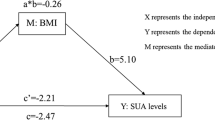Abstract
The Dietary Approaches to Stop Hypertension (DASH) diet lowers serum uric acid (SUA) levels compared to the typical American (control) diet. However, the time required for the DASH diet to take effect is unknown. We analyzed data from a parallel arm, randomized-controlled trial in pre-hypertensive or hypertensive adults (N = 103), comparing the effects of DASH or a control diet on SUA measured at 30, 60, and 90 days. Effects were examined overall and within stratified subgroups based on baseline SUA status (SUA ≥6 mg/dL vs <6 mg/dL). The mean age of participants was 51.5 ± 9.7 years, 55% were women, 75% were black, 42% were obese, and 34% had hypertension. Twenty-four of the 103 (23%) participants had a baseline SUA ≥6 mg/dL. Overall, compared to the control, DASH lowered SUA by 0.5 mg/dL at 30 and 90 days. Among participants with baseline SUA ≥6 mg/dL, DASH lowered SUA by 0.8 and 1.0 mg/dL at 30 and 90 days, respectively. These findings demonstrate that the DASH diet reduces SUA within 30 days, with a sustained effect at 90 days, which is informative for healthcare providers counseling patients on time course expectations for uric acid reduction in response to dietary modification.


Similar content being viewed by others
Abbreviations
- SUA:
-
Serum uric acid
- DASH:
-
Dietary Approaches to Stop Hypertension
- CI:
-
Confidence interval
References
Juraschek SP, Kovell LC, Miller ER III, Gelber AC (2015) Gout, Urate lowering therapy and uric acid levels among US adults. Arthritis Care Res 67:588–592. doi:10.1002/acr.22469
Choi HK, Mount DB, Reginato AM (2005) Pathogenesis of gout. Ann Intern Med 143:499–516. doi:10.7326/0003-4819-143-7-200510040-00009
Choi HK, Atkinson K, Karlson E et al (2004) Purine-rich foods, dairy and protein intake, and the risk of gout in men. NEJM 350:1093–1103
Choi HK, Liu S, Curhan G (2005) Intake of purine-rich foods, protein, and dairy products and relationship to serum levels of uric acid: the third national health and nutrition examination survey. Arthritis Rheum 52:283–289. doi:10.1002/art.20761
Huang H-Y, Appel LJ, Choi MJ et al (2005) The effects of vitamin C supplementation on serum concentrations of uric acid: results of a randomized controlled trial. Arthritis Rheum 52:1843–1847. doi:10.1002/art.21105
Juraschek SP, Miller ER, Gelber AC (2011) Effect of oral vitamin C supplementation on serum uric acid: a meta-analysis of randomized controlled trials. Arthritis Care Res 63:1295–1306. doi:10.1002/acr.20519.Effect
Zhang Y, Chen C, Choi H et al (2012) Purine-rich foods intake and recurrent gout attacks. Ann Rheum Dis 71:1448–1453. doi:10.1136/annrheumdis-2011-201215
Juraschek SP, Gelber AC, Choi HK et al (2016) Effects of the dietary approaches to Stop hypertension (DASH) diet and sodium intake on serum uric acid. Arthritis Rheumatol. doi:10.1002/art.39813
Appel LJ, Moore TJ, Obarzanek E et al (1997) A clinical trial of the effects of dietary patterns on blood pressure. N Engl J Med 336:1117–1124. doi:10.1056/NEJM199704173361601
Svetkey LP, Sacks FM, Obarzanek E et al (1999) The DASH diet, sodium intake and blood pressure trial (DASH-sodium): rationale and design. DASH-sodium collaborative research group. J Am Diet Assoc 99:S96–104. doi:10.1016/S0002-8223(99)00423-X
Sacks F, Svetkey L, Vollmer W et al (2001) Effects on blood pressure of reduced dietary sodium and the dietary approaches to Stop hypertension (DASH) diet. N Engl J Med 344:3–10
Khanna D, Fitzgerald JD, Khanna PP et al (2012) 2012 American College of Rheumatology guidelines for management of gout. Part 1: systematic nonpharmacologic and pharmacologic therapeutic approaches to hyperuricemia. Arthritis Care Res (Hoboken) 64:1431–1446. doi:10.1002/acr.21772
Juraschek SP, McAdams-Demarco M, Gelber AC et al (2016) Effects of lowering glycemic index of dietary carbohydrate on plasma uric acid levels: the OmniCarb randomized clinical trial. Arthritis Rheumatol 68:1281–1289. doi:10.1002/art.39527
Egan BM, Weder AB, Petrin J, Hoffman RG (1991) Neurohumoral and metabolic effects of short-term dietary nacl restriction in men relationship to salt-sensitivity status. Am J Hypertens 4:416–421. doi:10.1093/ajh/4.5.416
Dalbeth N, Ames R, Gamble GD et al (2012) Effects of skim milk powder enriched with glycomacropeptide and G600 milk fat extract on frequency of gout flares: a proof-of-concept randomised controlled trial. Ann Rheum Dis 71:929–934. doi:10.1136/annrheumdis-2011-200156
Harsha DW, Sacks FM, Obarzanek E et al (2004) Effect of dietary sodium intake on blood lipids: results from the DASH-sodium trial. Hypertension 43:393–398. doi:10.1161/01.HYP.0000113046.83819.a2
Acknowledgements
Supported by cooperative agreements and grants from the National Heart, Lung, and Blood Institute (U01-HL57173, to Brigham and Women’s Hospital; U01-HL57114, to Duke University; U01-HL57190, to Pennington Biomedical Research Institute; U01-HL57139 and K08 HL03857-01, to Johns Hopkins University; and U01-HL57156, to Kaiser Permanente Center for Health Research) and by the General Clinical Research Center Program of the National Center for Research Resources (M01-RR02635, to Brigham and Women’s Hospital, and M01-RR00722, to Johns Hopkins University). NIAMS R01-AR065944, to Massachusetts General Hospital.
OT is supported by the NIH Medical Scientist Training Program Grant 5T32GM007309. SPJ is supported by a NIH/NIDDK T32DK007732-20 Renal Disease Epidemiology Training Grant.
Author information
Authors and Affiliations
Corresponding author
Ethics declarations
Disclosures
None.
Additional information
This trial is registered at clinicaltrials.gov, number: NCT00000608
Electronic supplementary material
Supplemental Table S1
(DOCX 14.4 kb)
Supplemental Table S2
(DOCX 12 kb)
Supplemental Table S3
(DOCX 12 kb)
Supplemental Table S4
(DOCX 12 kb)
Rights and permissions
About this article
Cite this article
Tang, O., Miller, E.R., Gelber, A.C. et al. DASH diet and change in serum uric acid over time. Clin Rheumatol 36, 1413–1417 (2017). https://doi.org/10.1007/s10067-017-3613-x
Received:
Revised:
Accepted:
Published:
Issue Date:
DOI: https://doi.org/10.1007/s10067-017-3613-x




